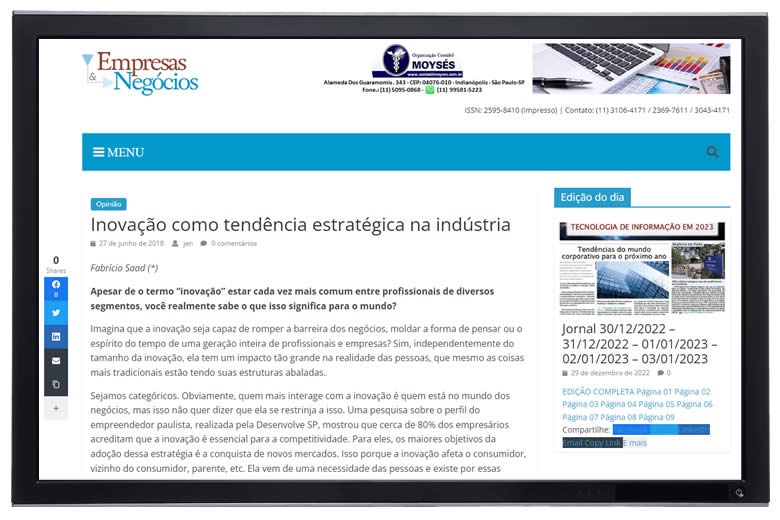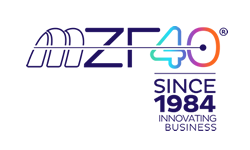Empresas & Negócios: Strategic trend
Innovation as a strategic trend in industry
(Fabrício Saad)
Although the term “innovation” is increasingly common among professionals in various segments, do you really know what it means for the world?
Can you imagine innovation being able to break the business barrier, shape the way of thinking or the spirit of time of an entire generation of professionals and companies? Yes, regardless of the size of innovation, it has such a huge impact on people’s reality that even the most traditional things are having their structures shaken.
Let’s be categorical. Obviously, those who interact most with innovation are those in the business world, but that doesn’t mean it is restricted to that. A survey on the profile of São Paulo’s entrepreneurs, carried out by Desenvolve SP, showed that around 80% of businessmen believe that innovation is essential for competitiveness. For them, the greatest objectives in adopting this strategy is the conquest of new markets. This is because innovation affects the consumer, the consumer’s neighbor, relative, etc. It comes from a need of the people and exists for them.
The survey showed that 74% of respondents consider innovation as something beyond the creation of a new or revolutionary product. This is because innovation exists in the way of thinking of a much larger portion of the population. It is in each person. In the desire to be better served; in the need for immersion; in the liking and sharing of social networks; in the behavior that motivates companies.
It is a process that feeds back, going from the company to the consumer, and vice versa. It is a change in the being and living reality of people. Businesses learn from observing this whole process. Innovation can come from any department within a company, usually linked to a need or a new way of observing something old; be it a process, a product, the way of talking to your team and customers. Innovation is a mental model. That means it is something alive, organic, running through the veins of everyone involved, from the CEO to the shop floor. It is a culture.
There is countless content available on the topic. Some mention that innovation can take the form of new products for new markets, new products for the same market, improvements to existing products or even the development of similar products, only cheaper, in order to reach another public. There are also those who think that innovation is only what is linked to technology – which is a big mistake, since technology is only one of the means that enables innovation and not an end.
In this sense, it is also common to hear the term disruptive innovation. According to the dictionary, disruption means “that which breaks or changes something”. In other words, a disruptive innovation is only that which has the power to change everything that came before it. A good example is smartphones, which broke with previous habits in the use of mobile phones. Another example is Uber, which changed the way people get around in large urban centers.
However, innovation is not and does not need to be only a technological or disruptive creation. Innovation can be the creation of a new process or just the improvement of something already existing. Innovating in services, improving production, reinventing distribution, all these are ways of innovating. And this attitude demonstrates that innovation is accessible to all, regardless of size or segment of activity. Innovation is democratic, and the more creative it is, the better.
Logically, innovating is not easy. It requires effort and team spirit. Hardly anyone can innovate alone. Normally, it is common to find a lot of resistance to innovation, after all, it requires leaving the comfort zone, seeking alternatives to do more, or better, with the same or even fewer resources. But it is an effort that is always worthwhile. An innovative company is always looking to grow, not only in numbers, but in the sense of going beyond what it has already been.
A good example of a company that has adopted innovation as a market strategy is Mazzaferro, a family industry in the nylon segment, which has been operating for 65 years. The most interesting thing is that even though it has a consolidated market, tradition, and is a vanguard company, age has not become synonymous with comfort. The company could have a good market share, be a leader in its original area of operation, but it did not settle in its position. It went in search of new opportunities, even opening up unknown markets.
Of course, this did not happen overnight. Her first step was to seek professional help. Innovation does not mean betting on everything that shines. The board of directors went back to their school benches in order to understand the transformations in the world and discover in which new markets they could operate. It was at this moment that they understood that innovation was beyond the trend, it was not a fad or a nice word used in a new context. It was something that could be used on a daily basis, as a strategy.
With efficient guidelines and metrics (after all, you can’t run away from the numbers and bet on guesswork) the company invested in new product lines, went from yarn to strands of locks for the beauty segment. It went through the production of brooms, medical sutures, professional guitar strings, among many other new products. They expanded and transformed the raw material that would be commodity, starting to observe more who is at the other end of the business and what he or she wants. High added value products.
It was not an easy process. It was necessary to create a new dialogue with the consumer. They went further and looked to the academy for a new marketing and innovation director. In the end, it all paid off, simply by being creative, not restricting themselves, not accommodating themselves, but innovating in a thoughtful way.
Like this success story, there are certainly many other companies, large or small, daring or conservative, of products or services, which are finding in the path of innovation the ideal strategy to maintain or grow in the face of so many challenges. For those who seek to surpass themselves before a competitor does, this is the best alternative.
Seek help in an organized way. If there is a risk in innovating in times of new technologies, the much greater risk is not innovating.
Fabrício Saad is statistician with MBAs at Kellog School (USA) and CUOA Foundation (Italy), is CMO of Mazzaferro S/A and professor of graduate studies at ESPM.

Published in Empresas & Negócios website on June 27th, 2018:
jornalempresasenegocios.com.br/opiniao/inovacao-como-tendencia-estrategica-na-industria


